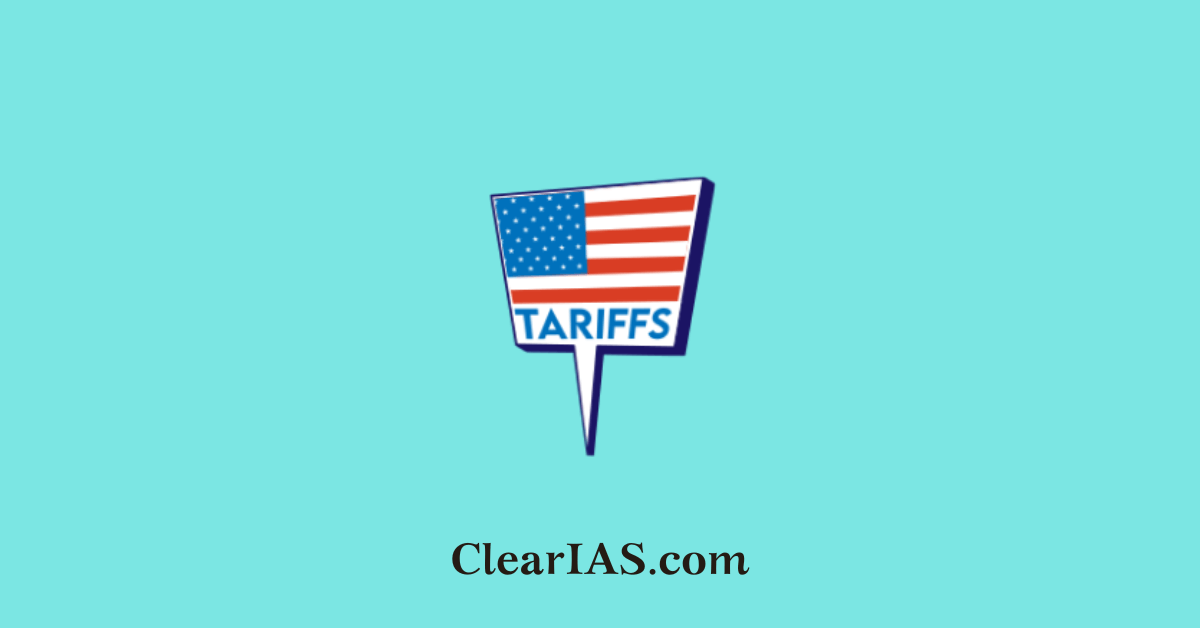
US Tariffs on Indian Exports are a significant shift from established trade norms. Read here to learn of the impact this will have on the Indian economy and trade relations with the US.
In a notable departure from long-standing trade arrangements, the United States under President Donald Trump imposed 25% tariffs on Indian imports, including pharmaceutical products.
In 2025, the U.S. escalated its stance by announcing a 26% reciprocal tariff on India (currently on hold), signalling a more protectionist and strategic trade approach.
These actions follow the earlier withdrawal of India’s benefits under the Generalised System of Preferences (GSP) in 2019 and reflect growing strains in India-U.S. trade relations.
US Tariffs on India
- Widening Trade Deficit
- In 2024, the U.S. recorded a $45.7 billion goods trade deficit with India, a 5.4% increase from the previous year.
- The U.S. seeks to rebalance trade by pressuring India to open up more sectors.
- Non-Tariff Barriers Allegation
- India’s sanitary and phytosanitary (SPS) standards, agricultural subsidies, and market access restrictions are viewed by the U.S. as discriminatory and protectionist.
- Geostrategic Factors
- India’s continued engagement with Russia, especially in defence and energy sectors, is under scrutiny amid the U.S. push to isolate Russia post-Ukraine conflict.
- The proposed Russian Sanctions Act (2025) threatens 500% tariffs on countries importing Russian petroleum products—implicitly targeting India.
- India’s Role in BRICS
- India’s deepening role in BRICS, which promotes de-dollarisation and a multipolar economic order, is perceived as undermining U.S. financial hegemony.
Potential Implications of Tariff Impositions
- Strain on Bilateral Trade Negotiations
- The tariffs may be a pressure tactic to accelerate negotiations for a Bilateral Trade Agreement (BTA).
- Both countries aim to increase bilateral trade to $500 billion by 2030 (up from $131.8 billion in 2024), but protectionist measures may derail progress.
- Impact on Indian Exports
- India is a leading supplier of generic (non-patented) drugs to the U.S., and higher tariffs will increase healthcare costs in the U.S. while hurting Indian pharma margins.
- Other affected sectors may include textiles, chemicals, automotive components, and steel.
- Competitive Disadvantage
- Tariff rates on India (26%) exceed those imposed on regional peers like Vietnam (20%) and Indonesia (19%), potentially diverting U.S. trade toward competitors.
- Supply Chain Disruptions
- Tariff barriers could lead to shipment delays, cost inflation, and deter U.S. companies from sourcing critical inputs from India.
- Pressure on R&D and Innovation
- Declining profits in the pharmaceutical and tech sectors may hamper India’s innovation capacity, regulatory clearances, and international competitiveness.
Impacts on India-U.S. Trade Relations
On the Indian Pharmaceutical Sector:
- Profit Margins Decline: Tariffs erode the cost advantage Indian firms had in the U.S. generics market.
- R&D Slowdown: Reduced earnings may lead to cutbacks in innovation, clinical trials, and global regulatory filings.
- Supply Chain Disruptions: May affect Indian firms with U.S.-focused production lines and API exports.
On the U.S. Healthcare System:
- Higher Drug Costs: Indian generics play a major role in lowering drug prices in the U.S.; tariffs may inflate costs for insurers and patients.
- Delayed Treatments: Potential shortages of affordable drugs may affect chronic disease management and public health programs.
On Bilateral Trade Dynamics:
- Escalates trade tensions between India and the U.S.
- Undermines strategic cooperation, especially in sectors like healthcare, digital trade, and IP.
India’s Response and Strategic Outlook
India has emphasized that it remains committed to a fair, balanced, and mutually beneficial trade agreement, guided by its national interests, particularly:
- Farmer welfare
- MSME protection
- Technological sovereignty
- Energy security and strategic autonomy
Rather than submit to unilateral pressure, India has adopted a calibrated trade strategy, balancing engagement with the U.S. while pursuing FTA negotiations with the EU, UK, UAE, and Australia.
Way Forward
- Negotiated Solutions: Through bilateral trade talks or WTO mechanisms.
- Diversification: Indian pharmaceutical firms must expand into non-U.S. markets (e.g., the EU, Latin America, Africa).
- Atmanirbhar Bharat Push: Enhance domestic R&D, API production, and reduce export dependency.
Conclusion
While the U.S. tariffs reflect evolving geopolitical and economic frictions, they also highlight the need for structured and cooperative trade frameworks.
For both countries, linked by democratic values and economic complementarities, focusing on negotiated solutions over protectionist retaliations will be key to ensuring a resilient, future-ready economic partnership.
Related articles:







Leave a Reply